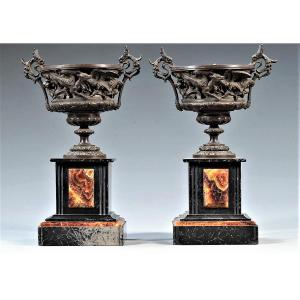Pretty Porcelain Bowl In A Bronze Frame - Japan - Eighteenth Century
Porcelain bowl with blue, red, green and gold decoration called Imari of flowers.
18th century period
Japan
It is set in a chiseled and gilded bronze mount forming a cup (19th century).
High. 19cm, Length. 23cm
Imari porcelain designates a place of production of Japanese ceramics, made in the former province of Hizen on the island of Kyûshû, which substantially corresponds to the domain of Saga, and mainly in the kilns of the city of Anta. Until the end of the 18th century, the porcelains of this province were grouped together and exported from the port of Imari, which gives its name to this production. But we also use “Anta porcelain” to designate the same thing. A large number of styles are distinguished, but the dates often remain approximate, at least for the oldest.
The kinrande style can be recognized by its three dominant colors: cobalt blue, iron red verging on saffron and the white background of porcelain (these colors are not exclusive); everything is enhanced with gold. The iconographic register, very floral, integrates elements from the animal kingdom and the mineral world.
The brocade effect (of fabric) often obtained, both by the patterns, by the play of colors and by the composition, could only flatter the European courts avid of trompe-l'oeil, Its artists showed imagination in the decorations and freedom in the forms. They had a very original way of exploiting space and they had a sense of asymmetrical compositions.




































 Le Magazine de PROANTIC
Le Magazine de PROANTIC TRÉSORS Magazine
TRÉSORS Magazine Rivista Artiquariato
Rivista Artiquariato